Normally all my trips are planned in advance. I would have my booklet mapping all the places to cover, a rough idea of the time required at each place, weather condition so I pack accordingly, bookings in advance to avail the best deals etc…
What made the Rajasthan trip incredible for me is :
- We used “makemytrip.com” to book all the hotels, flights and rail journey, all of this 2 days before our planned travel date.
- We had only 4 days and 3 cities to cover so mapped all the places of interest on the last day.
- Thanks to the great roads between most places in Rajasthan, the not-so-humid weather and the air-conditioned cars the long drives were bearable.
- We had breakfast in one city and dinner in another so this was quite an experience!
Every city in Rajasthan makes a tourist want to camp for a few days and explore its forts, havelis, lakes, shopping districts and nearby getaways in luxury. But if you’ve got only a couple of days like us and want to sample every part of the state, the good news is you can do it in an exhausting but delightful journey!
So the three of us started from Mumbai in the early hours on the morning of the 2nd March and returned on the early am flight on the 6th of March. Four days of the most incredible sights, sounds and taste of Royal Rajasthan. The gentle winter sun allowed us to walk around exploring the forts and palaces even in the afternoons.
The most concentrated way to get to know the region is through its three main cities: Jaipur, Jodhpur and Udaipur, each with its own flavor. We started from the ‘Pink City’ – Jaipur, to the ‘Lake city’ – Udaipur, to the ‘Blue city’ – Jodhpur and back to Jaipur for our return flight. The 4 day trip for 3 people cost us Rs. 80k (flights, accommodation, meals, entry tickets + guide, rail and road transfers, toll etc.- all inclusive).
« »

JAIPUR: An exotic cityscape completely washed in a soft, glowing shade of blush that deepens as the sun sets each evening. Pedestrians from all walks of life, seemingly from a mix of centuries weave through the boulevards and bazaars amid a cavalcade of rickshaws and motorbikes, three-wheeled trucks and elephants, all buzzing with a vibrant exuberance.

UDAIPUR: The intricately connected lakes, the majestic architectural wonders, the breath-taking views, the temples, gardens, forts, everything here scream the testimony of the city’s heroic past. The land of the Maharajas still stand tall and proud with open arms inviting everyone to join it on the royal journey of the glorious, exquisite and magnificent by-gone era of India.

JODHPUR: Set at the periphery of Thar Desert, Jodhpur echoes with tales of rich cultural heritage and legacy. This fairytale-like former princely state is an amazing concoction of dazzling colors, magnificent sights and humble residents.
 « »
« »
Day 1: JAIPUR
We took the early am Indigo flight from Mumbai to Jaipur. Upon arrival at Jaipur airport we booked a taxi at the airport (counter is located on the left side of the exit door) since they were cheaper than the hotel. Paid Rs 400 for a 20 min drive and reached the Holiday Inn City Centre around 9 am. The hotel is located in close proximity to the areas of interest, railway station and shopping and also convenient access to all the historical monuments in Jaipur so if you, like us, are short on time this is a fabulous stay option. Rooms are spacious (accommodates an extra bed) and the bathroom immaculate. Buffet breakfast in the Monarch hotel had a good spread of local and continental cuisine. The hotel had complimentary wi-fi access. We were also offered a discount on our breakfast by their guest service champion, Sonam Rajput.

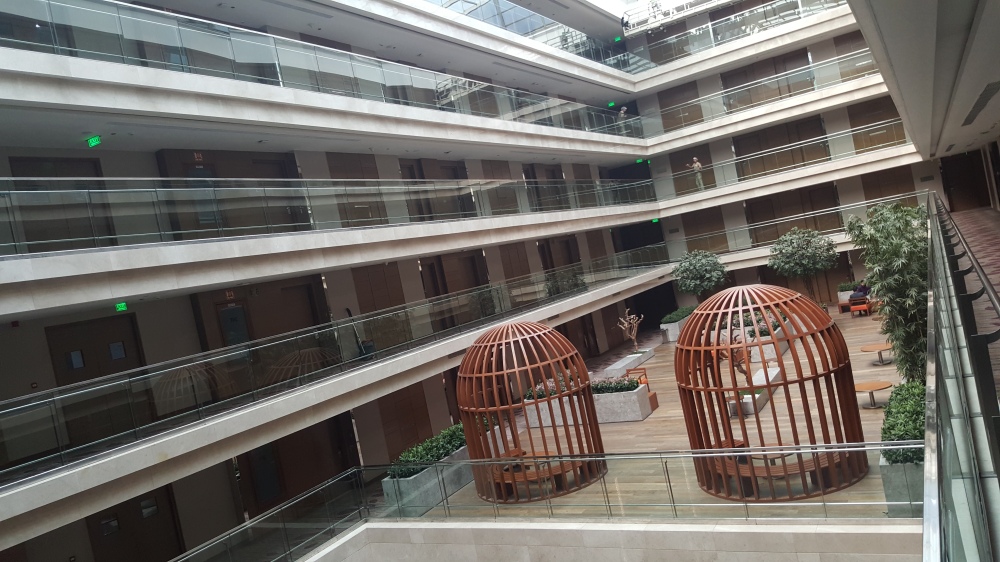




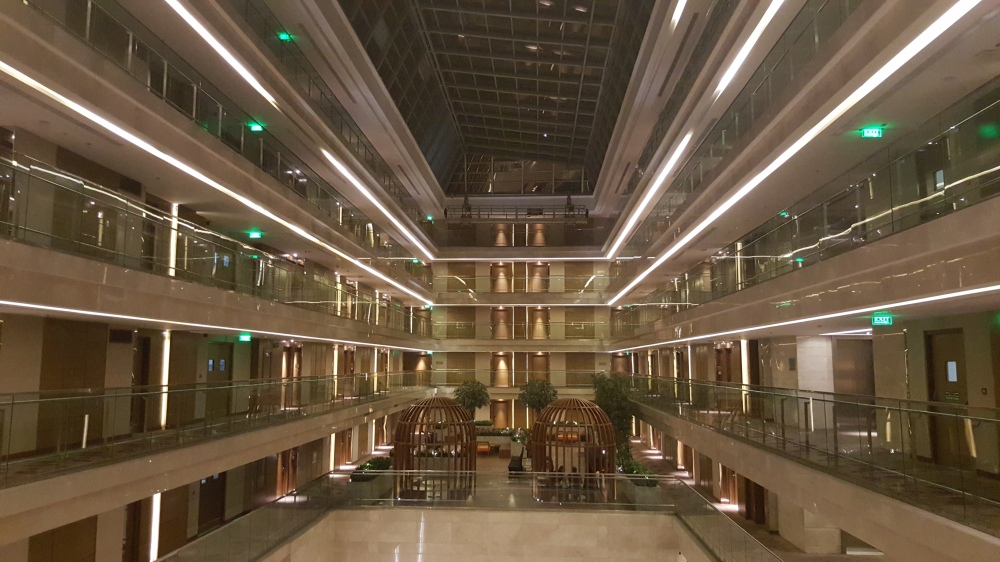
We were in Jaipur only for a day as we had to leave for Udaipur early am the next day. We decided to consult Sonam who provided us with a tourist map and suggested we visit Amer Fort. According to her whatever else you miss in Jaipur, don’t leave out Amer Fort. So post breakfast in Monarch restaurant we booked an Uber and were on our way to Amer Fort/Palace. Drive from the hotel to Amer Fort was supposed to be ~30 mins but it took us close to 2 hours since the city was hosting the Kalash Yatra (images below) owing to which traffic was crawling all over Jaipur.


Once we reached the fort, we hired a local tour guide, Sonu who was standing outside the fort. He was quite funny (Raja Hindustani type guide) and knew quite a lot about the history of the place.

Amer Fort: Standing so high up, looking down at the Aravali ranges stretching to the horizon, the structure blended beautifully with the mountains.

The name ‘Amber’ comes, not from the English word for the color, but is a derivation of the word “Amba” or the goddess. However, it is pronounced as ‘Amer’. The spelling varies too, with both usages – Amber and Amer – being quite commonly used.

The sprawling, sturdy structure of the fort exudes elegance even from the outside, its red sandstone walls bright against the green water of the natural moat formed by Maota Lake, and its white marble domes glowing in the sun.

The interior of the fort has exquisitely carved walls, roofs and terraces, separated by manicured garden mazes. Combining Islamic and Rajput architectural styles, the construction of the fort began in 1592. The most beautiful part of the fort is the Sheesh Mahal. It is said a single ray of light could illuminate the entire hall, because of the clever placement of the tiny mirrors within. The precious jewels that once decked the inner walls of the palace have been lost in raids.


A visit to the Amber Fort starts with the Jaleb Chowk, a large rectangular courtyard. The main gate of the fort called Suraj Pol or ‘Sun Gate’ (‘suraj’ meaning sun and ‘pol’ meaning gate) leads to the main courtyard of the fort, Jaleb Chowk, where the army used to parade in front of the king and his courtiers. The Chand Pole, the Moon Gate, is on the opposite side. If one enters from the Suraj Pole, there are shops on the left side. On the right side is the highly revered temple of goddess, Shila Devi. Also, on the right side is the Singh Pol, a gateway leading to the rest of the fort.


Amber Fort is close to the Maota Lake. There is a nice garden at the lake and as seen from the higher floors of the fort, the garden makes a great view.







After almost 2 hrs of touring this fabulous fort, we booked an Uber again from the Fort to City Palace. Enroute we stopped to take a pic in front of Jal Mahal which is set in the centre of Lake Mansagar and is one of the most photographed monuments in Jaipur.

One of the entrance gates to the Old City of Jaipur where the streets were lined with shops and markets selling everything you could imagine. There were a few gates on each side of the walled portion of the city and from the color you can clearly see why it is known as the “Pink City”. It was founded in 1727 by (and named after) Jai Singh II when he shifted the capital of his kingdom from Amer to the present location of Jaipur.

City Palace Jaipur, Hawa Mahal and Jantar Mantar make up the three main attractions in the Old City of Jaipur. However owing to time constrains we only managed to see the City Palace.



The City Palace is a very popular tourist spot and offers a great view of the Pink city. Part of the palace, the Chandra Mahal, is occupied by the Royal Family. Inside the Palace are decorative state rooms, art museums, extensive armory and the world’s largest silver object – a giant water jar. It is advisable to pay for a local guide or an audio guide at an additional cost. The ticket counter is located on the left side after the main gate and the available guides usually sit near the counter.


City Palace Jaipur was built between 1727 and 1732 by Sawai Jai Singh II, the founder of the city of Jaipur, who also built the Hawa Mahal and Jantar Mantar. The architecture of City Palace Jaipur is based on a fusion of the Vastu Shastra of Indian architecture – combining Rajput, Mughal and European styles of architecture. Part of City Palace Jaipur is a museum; the other part is the residence of the descendents of the former rulers of Jaipur. City Palace Jaipur can be accessed through any entrance gate except for Tripolia gate which is reserved for the royal family.


Chandra Mahal is the most impressive palace in the complex. It is a seven-storied palace used as the residence by the royal family. Inside the Chandra Mahal, there are palaces like Sukh Niwas, the living room, Sri Niwas the Mirror Palace, Chavvi Niwas, the Blue Palace and Shobha Niwas, the Ceremonial Hall. The flag of the Maharaja flies on top of the palace. It indicates that the king is in the palace. When the king is away, the queen’s flag is hoisted.


In an inner courtyard called Pritam Niwas Chowk, there are four doorways in the walls. For me this was the most impressive part of the tour. Each of these doors is unique in its design and decoration and beautiful to behold. The four doors represent the four seasons of the year and the different Hindu gods.



I missed taking a pic of the fourth gate – The Green gate representing Spring which is dedicated to Lord Ganesha.
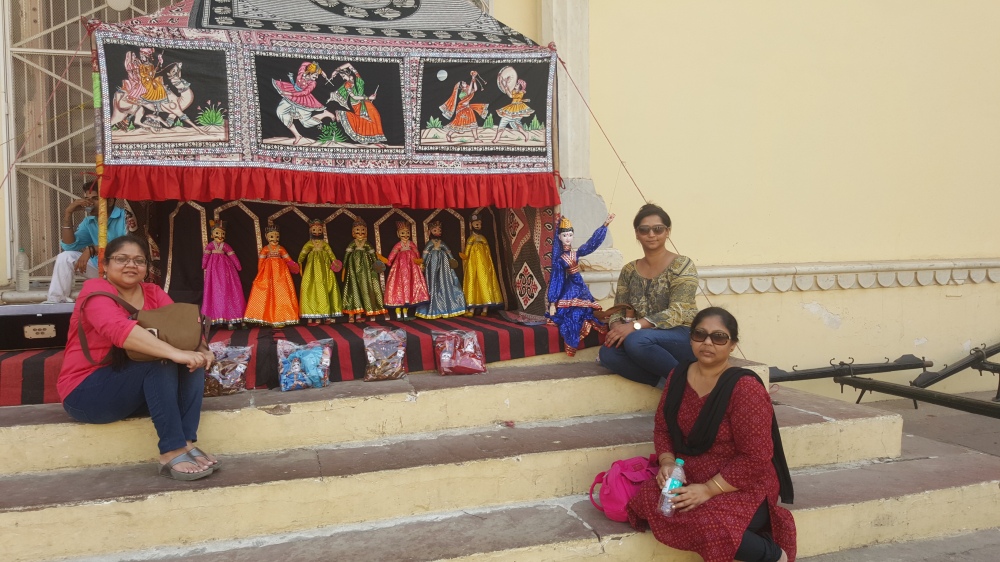

One of the most interesting items in the palace are two sterling silver jars that are officially recorded by the Guinness Book of World Records as the world’s largest sterling silver vessels.

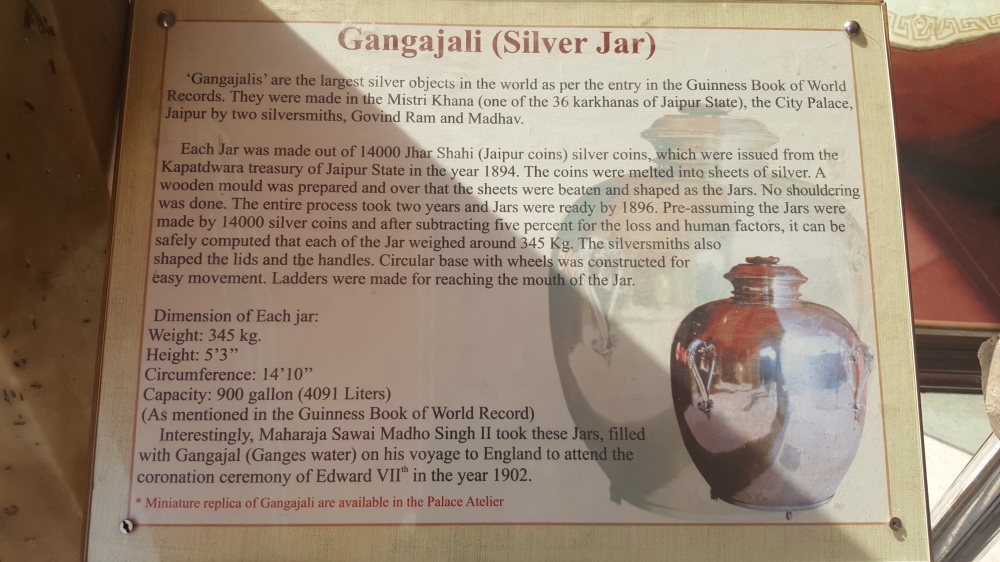



 Mubarak Mahal is set out in the center of a courtyard, next to Sarvato Bhadra. Mubarak means auspicious. So Mubarak Mahal is literally an auspicious palace. It was made as a reception center in the late 19th century by Maharaja Madho Singh II. Now it is a museum displaying textiles and costumes used by the royalty in the past.
Mubarak Mahal is set out in the center of a courtyard, next to Sarvato Bhadra. Mubarak means auspicious. So Mubarak Mahal is literally an auspicious palace. It was made as a reception center in the late 19th century by Maharaja Madho Singh II. Now it is a museum displaying textiles and costumes used by the royalty in the past.




After spending time and appreciating the fine art in the palaces, it was time to relax. The Baradari restaurant which replaced the City Palace restaurant was just the right place for its great ambience and delicious but pricey food (meal for 3 was Rs. 2,000). The restaurant offers contemporary Rajasthani cuisine alongside continental dishes inspired by the region.


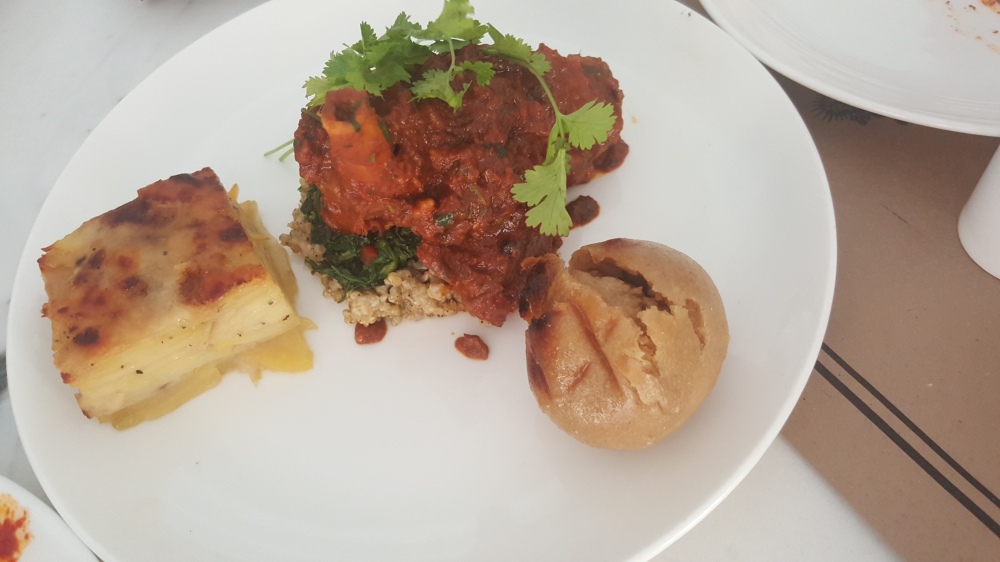


Post lunch we took an e-rickshaw from outside the Palace to Maharani Market on the suggestion of the driver but this can be completely avoided as there the market has very few shops. Later on we visited Bapu Bazaar, Johari Bazaar and MI Road. We only managed to visit a few stores since most of the shops were closed that day owing to the yatra. We picked up some stuff from Cottons (my absolute favorite store for cotton wear) and Anoki (pricey but good collection).






Day 2: UDAIPUR
We took the 6.15 am super fast train from Jaipur Railway station which had 10 halts between Jaipur and Udaipur. The journey was quite comfortable since we had booked the 3 tier A/C berth so slept most of the time. The staff provided clean sheets and pillows and vendors came mid-way through the journey selling tea and breakfast consisting of bread and veg cutlet (chargeable). It took ~7 hrs from Jaipur to Udaipur station so we reached Udaipur railway station around 1.10 pm.




We had called the hotel the previous day to book a pick-up, however they confirmed that there were several taxi and rickshaw options outside the station which seemed to be the case. We traveled with a very friendly Sardi driver who recommended some key places to visit in Udaipur. A short drive and we were at the jüSTa Rajputana hotel where we were greeted with a refreshing welcome drink. To our great luck there was a wedding taking place the following day owing to which the groom’s family had booked the entire wing comprising of the deluxe rooms so we got upgraded to a villa room. We actually had a look at their deluxe and premier rooms which was above average however would highly recommend the villa room! Hotel provides free internet connection.

















The event coordinators were setting up the venue for the wedding so managed to get some pics of the decorations.


At Udaipur station you will find tour operators and car rental owners vying for business. We spoke to Kallubhai who owns a fleet of 4 cars and after negotiating a rate for the next two days he sent his driver, Kamlesh to collect us around 2.30 pm. I highly recommend this company (biz card below) and request for driver Kamlesh. Since we were 3 female travellers we were extremely comfortable with Kamlesh who went out of his way to ensure we had a pleasant journey and shared all his amazing travel experiences with us which made the long drives quite interesting.

We were way past lunch time so Kamlesh took us directly to Nataraj Hotel to taste some authentic Rajasthani food. We decided to sit in the dining hall instead of the restaurant. Quick, delicious and filling are apt words to describe the thali that Natraj has to offer. Unlimited food, ghee smeared chapatis, khichri again smeared with ghee and chaas cost us only Rs. 200 per person so this was an extremely cheap dining option.


Post lunch our first stop was Udaipur City Palace.
The City Palace of Udaipur is a majestic complex located on the east bank of Lake Pichola. It was built by the Maharana Udai Singh as the capital of the Sisodia Rajput clan in 1559, after he moved from Chittor. Udaipur was the historic capital of the former kingdom of Mewar in the Rajputana Agency and its last capital. With gardens, birth charts, galleries of paintings, armouries, painted tablets, decorated alcoves, and memorabilia dating back centuries, the City Palace is a tourist delight – part of which is the living quarter of the erstwhile royal family. This palace is an unmatched sample of status, prestige and elegance of the Mewar Dynasty who ruled over Udaipur.
Hence no trip to Udaipur is complete without doing 2 of the must-see attractions of Udaipur – first, a tour around the City Palace of Udaipur (hear the stories of the heroics of the past Mahranas and see the beauty of the architecture and the palace grounds) and second, a sunset cruise around Lake Pichola to check out the beautiful lake palaces such as Jag Mandir.


The City Palace of Udaipur was built in a flamboyant style and is considered the largest of its type in Rajasthan, and was built on a hilltop that gives a panoramic view of the city and its surrounding.











 Situated inside the City Palace, Palki Khana is the best place to unwind after your long walks inside the Palace and the museum. You can sit outside, under Rajasthani umbrellas if you like to people-watch. The menu emphasizes standard Continental café fare, such as salads, sandwiches, pizza, and pasta. Beer and an extensive variety of international and Indian wines are also available.
Situated inside the City Palace, Palki Khana is the best place to unwind after your long walks inside the Palace and the museum. You can sit outside, under Rajasthani umbrellas if you like to people-watch. The menu emphasizes standard Continental café fare, such as salads, sandwiches, pizza, and pasta. Beer and an extensive variety of international and Indian wines are also available.


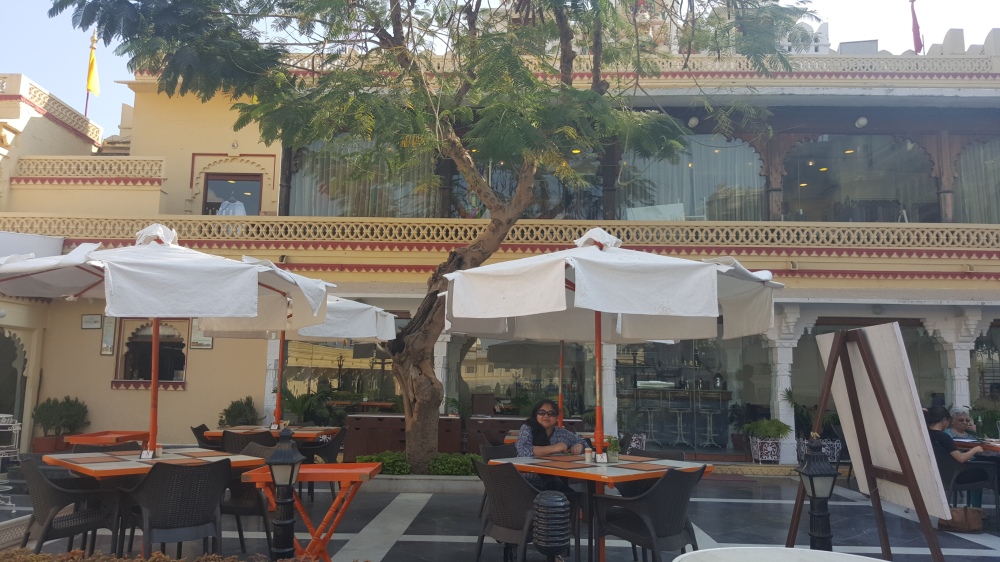

After a refreshing drink of lemon and mint at Palkhi Khana we took a boat ride on Lake Pichola which offers a spectacular view of the Jag Mandir, City Palace and Lake Palace. Our driver mentioned that if you book the ride from the palace grounds it cost 4 times more than the route used by locals. On the banks of Lake Pichola is one of India’s few cable car ropeways which offers spectacular views of the five lakes as well as the City Palace and Sajjangarh Fort. Owing to time constrains we were unable to do this so adding it to my “to do list” for next time.
Udaipur is often referred to as the Venice of India because of the various lakes. Located in the heart of Udaipur, Pichola is the oldest and one of the largest lakes in all of Udaipur. In 1362 AD Pichola Lake was built by Banjara, a grain merchant with the intention of allowing his carts of food grain to cross over during the monsoon. Later, Maharana Udai Singh, affected by the charm of this lake the lake when he founded the city of Udaipur and also built a dam made of stone that is in the Badipol region on the shore of the lake. Pichola Lake is enveloped by lofty Palaces, temples, bathing ghats and elevated hills on all its sides.


During the ride the amazing view of the City Palace, the Lake Palace (which is a Taj hotel), the Jagmandir and all other luxury hotels lined up along the edge of the lake, was simply mesmerising.
Lake Palace (formerly known as Jag Niwas) is a luxury hotel, which has 8 rooms and suites featuring white marble walls. The Lake Palace is located on the island of Jag Niwas in Lake Pichola, Udaipur. It was built between 1743 and 1746 under the direction of the Maharana Jagat Singh II of Udaipur.

The City Palace of Udaipur broadens along the eastern banks of Lake Pichola. In 1983 James bond film Octopussy was shot here. Sound and light show is organised every evening at the magnificent Manek Chowk in the City Palace of Udaipur.



Jag Mandir is a palace built on an island in the Lake Pichola. The construction of the palace was started in 1551 by Maharana Amar Singh, continued by Maharana Karan Singh and finally completed by Maharana Jagat Singh I (1628–1652). Jag Mandir with sculpture of eight elephants adorning the entrance and facing the Lake Palace. Jag Mandir Palace includes Gul Mahal, which was built first as a refuge for Prince Khurram, the Garden Courtyard and the Darikhana on its northern side and Bara Patharon ka Mahal at the eastern wing of the main palace.



We then drove to Maharana Pratap Memorial which contains a fascinatingly realistic statue of Rana Pratap Singh riding his loyal horse Chetak. The memorial lies on top of a small hill which overlooks the Fateh Sagar Lake. At the bottom of the statue is the story of Battle of Haldi Ghati carved in brass. Both the statue and carving of the battle scene are salute to the Maharana Pratap’s bravery.







The scenic beauty of the place with its beautiful garden and slopes is breathtaking and the most striking thing is the panoramic view of whole Udaipur City.



Since we were thirsty Kamlesh suggested we try the dry fruit lassi at Chandan restaurant located at the base of the memorial. It is definitely a must-try.


A 2 minute drive takes you from the memorial to the museum where models of Chittorgarh and Haldi Ghati are available along with descriptive documentation. The beautiful paintings, models and weapons of the bygone era made me curious to learn more about the history on the rulers of Mewar.
I feel this is an apt way of teaching our kids to enjoy history by visiting it. It is all around us; as close as a museum or historic site where so many significant events took place. By introducing children to the past, we will provide them a chance to time-travel; fueling their curiosity and helping them.








It was around sunset when we drove past Fateh Sagar lake on to Sahelion ki Bari. The aura of sunset tinging the whole lake in its own myriad color is a sight to behold.


Sahelion ki Bari a sprawling complex containing lawns, flowerbeds, ponds and fountains. It is a garden of maids of honor which brings to the fore the unique life style of royal ladies who once lived in the glorious palaces of the city. This is a spectacularly well-maintained garden with fountains, flower, herbs, trees, lawns and almost everything which could be found in an enthralling utopian world of fairy-land.









The garden has four pools ornate with delicately chiseled kiosks, elephants in marble (each elephant sculptured out of a single piece of stone). Fountains surround a lotus pool, a marble throne and a settling room which has been adorned with enchanting paintings and glass mosaics. The garden boasts of almost 2000 fountains, small and big, and that too built at the time when there were no water pumps. These fountains are fed by the waters of Fateh Sagar Lake gushing through purpose-built ducts.

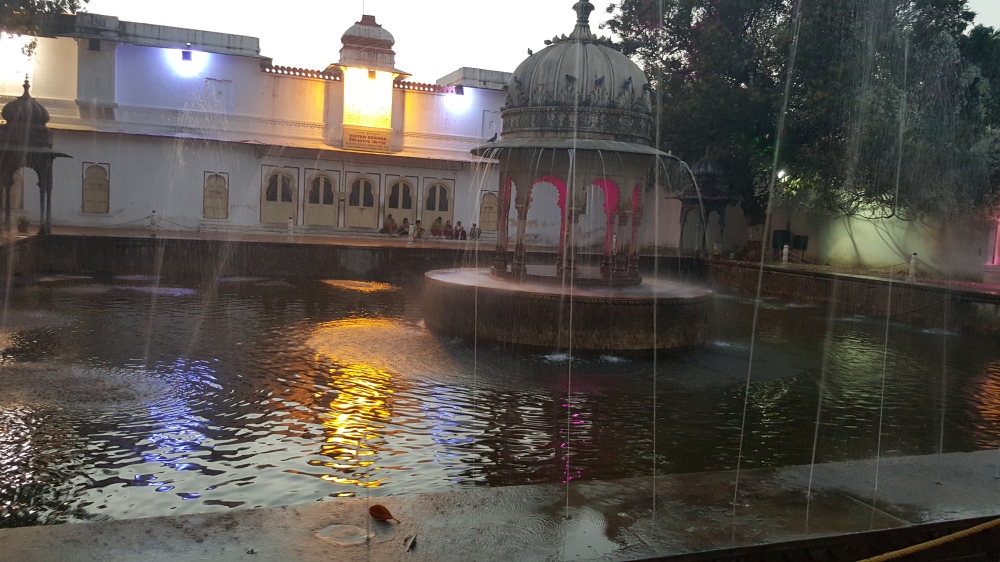





Each water channel was designed to create a distinct sound so that the mingling of these sounds would create music. There are five beautiful fountains – Swagat fountain, Savan Bhodo fountain, Kamal Talai fountain, Rasaleela fountain and Bin-Badal barsat fountain. In the old time the queens used to come with their friends hence it is called Saheliyon-Ki-bari.

Day 3: Kumbalgarh Fort en route to JODHPUR
Post breakfast we drove to Jodhpur with a quick stopover at Kumbalgarh. The 4 hour drive from Udaipur to Kumbalgarh through local villages was extremely scenic. Roads were a bit bumpy in between but overall a pleasurable drive.











We decided to stop at a road side joint for a quick bite. The masala chai and fafda dipped in lentil curry was simple yet delicious.



We arrived at Kumbhalgarh a little before noon. Kumbhalgarh is one of the biggest forts in the Mewar area of Rajasthan. It was built by Rana Kumbha in the 14th century to protect Mewar against the Mughal invaders. Though it is Rana Kumbha who is credited with building the present fort, there was an earlier structure at the same place built by the Jain King Samprati. The fort’s claim to fame lies in its 36 Km long wall, which is said to be the second largest after the Great Wall of China.















After spending an hour or so enjoying the festivities we left the fort and stopped at a local restaurant in Pali village called Shree Veer Mamoji Dhaba. We enjoyed a simple home cooked meal of bajra rotis, kadhi, tamatar sev and masala khichri. The restaurant had quite an extensive menu, however we went with the recommendation of the serving staff.




We reached Mehrangarh Fort around 4 pm. Standing a hundred feet in splendour on a perpendicular cliff, 400 feet above the skyline of Jodhpur, Mehrangarh Fort is one of the most magnificent forts in India. Imposing and invincible, the fort exudes both beauty and grandeur with its arched galleries and heavily ornamented private residences and seemingly miles of strategically twisty, misleading passageways and stairs as well as its museum which has a collection of palanquins, howdahs, weapons, paintings and clothes. All of it overlooks a sprawling desert city lined with the beautiful blue-washed houses.

We took the elevator all the way to the top, from where we were rewarded with a view of the Blue City spread out below, like a patchwork quilt.

Inside the fort the ornate palace walls are remarkably well preserved.

We gaped at the rooms full of treasures- a room only for the howdahs and palanquins that carried the king, another housing swords and shields and maces and guns of different eras, another with all the musical instruments ever invented (or so it seems). There were rooms for turbans and cradles and hookahs and paintings and furniture and whatever else you can think of.











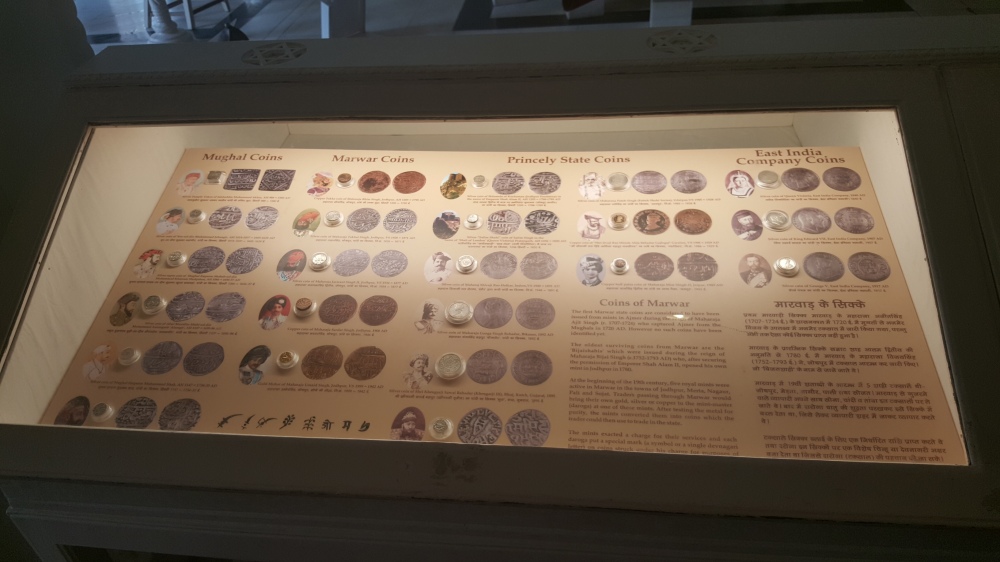



The palace rooms were breathtaking. None more so than the Maharajah’s bedroom where Christmas balls decorate the ceiling, delicate murals cover the walls and stained glass fills the windows.

There were two rooms that attracted tourists like fire attracts moths. The first was the Sheesh Mahal or the Mirror Palace, a room that is symbolic of Rajput grandeur and opulence. Covered from ceiling to floor and wall to wall with exquisite mirror work, the room is bathed in the light of a single chandelier that lends a golden aura to the place. I could not help but remember the famous song from Mughal-e-Azam, Pyaar kiya toh darna kya and Madhubala’s beautiful face reflected in the mirrors of a similar Sheesh Mahal.

The other room was the Moti Mahal or Pearl Palace, the durbar hall of the kings, where they conducted the proceedings of the court. Named after the pearly effect caused due to the lime plaster used, this hall had an interesting play of light and color happening, due to the light streaming in through the colored glass windows. The gold filigree on the ceiling, interspersed with mirrors, also took our breath away.
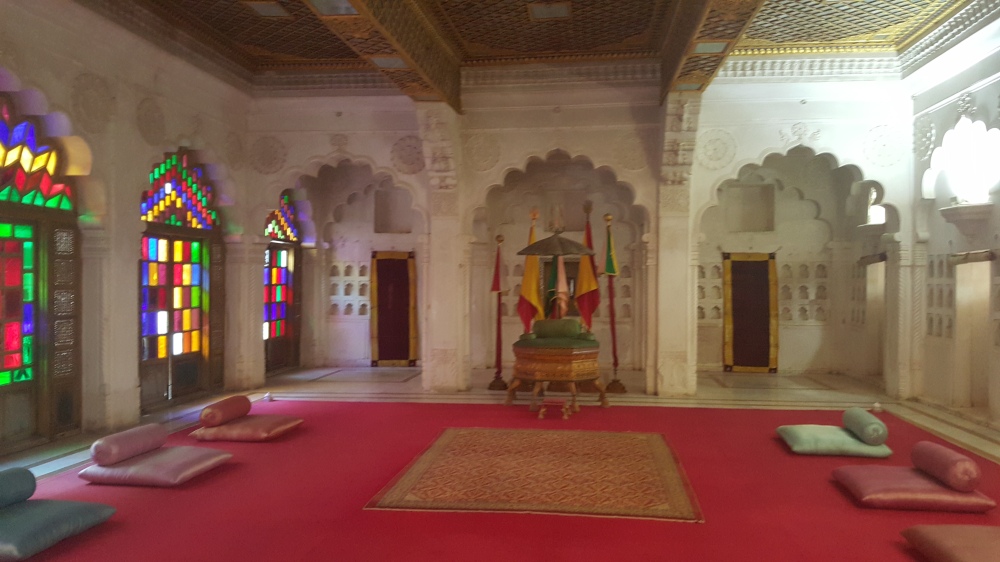
I was awed by the latticework we saw. In the windows, in the screens of balconies, in the zenanas of the queens and the mahals of the kings, the intricate sandstone jali work was spectacular. When you think that the latticework, in some places as detailed and fine as lace, was made by hand, without AutoCAD or any other modelling or designing software, and you come to appreciate the skill of the craftsmen, and rue the industrialization that has caused the vanishing of such skills.





Around the majestic Mehrangarh fort’s feet, Jodhpur unfolds into a jumble of blue-hued houses, medieval buildings and winding streets. The graceful palaces, forts and temples strewn throughout the city bring alive its famed historic grandeur.

Since we did not have much time on hand to scout the markets we stopped at National Handloom Emporium and purchased some good quality block print material and dhurries/quilts (with pashmina filling) followed by a quick bite at Janta Sweet Home (very popular joint in Jodhpur).






The imposing century-old clock tower is an old city landmark surrounded by the vibrant sounds, sights and smells of the Sardar Market. Narrow winding lanes and crowded alleys sell everything from vegetables, spices and sweets to silver and handicrafts.


We tried to book all the hotels in the heart of all the action of a city center except for Jodhpur since we had read some really good reviews on the WelcomHotel – a ten acre retreat on the edge of the Thar desert.
A tikha, welcome drink followed by a super quick check-in and we were in the lap of luxury. Our luggage arrived through a separate entrance freeing the lobby from the usual check-in clutter. The stark architecture draws inspiration from the desert oasis, with sandstone clad structures deliberately veering away from the ornate haveli aesthetic. Our spacious room on the second floor was beautifully laid with every conceivable comfort. The bathroom, equally spacious, sports a deliciously large soaking tub and a separate roomy shower. I loved the artifacts, myriad of colors, the jhoola and the lush greenery!

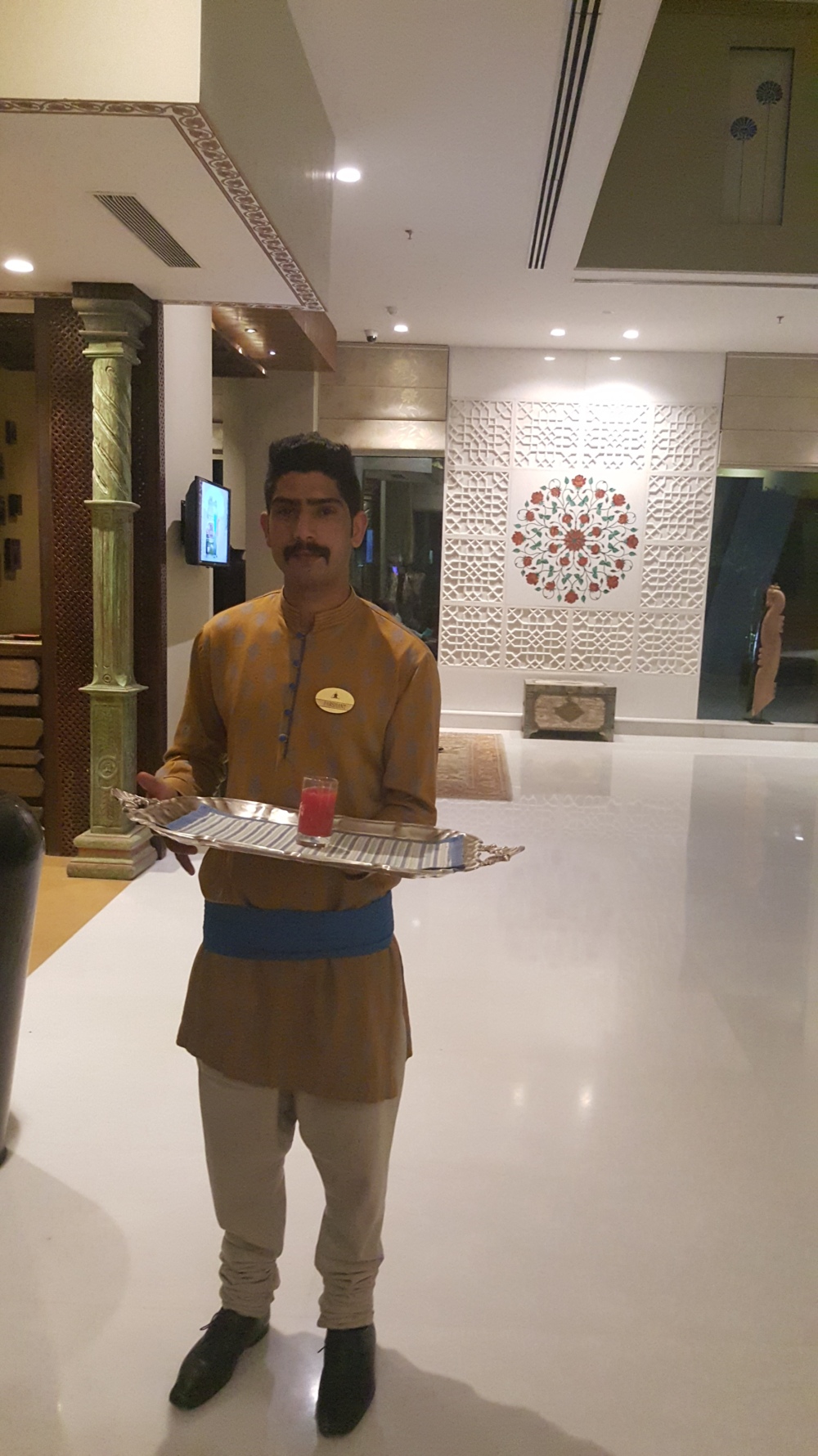





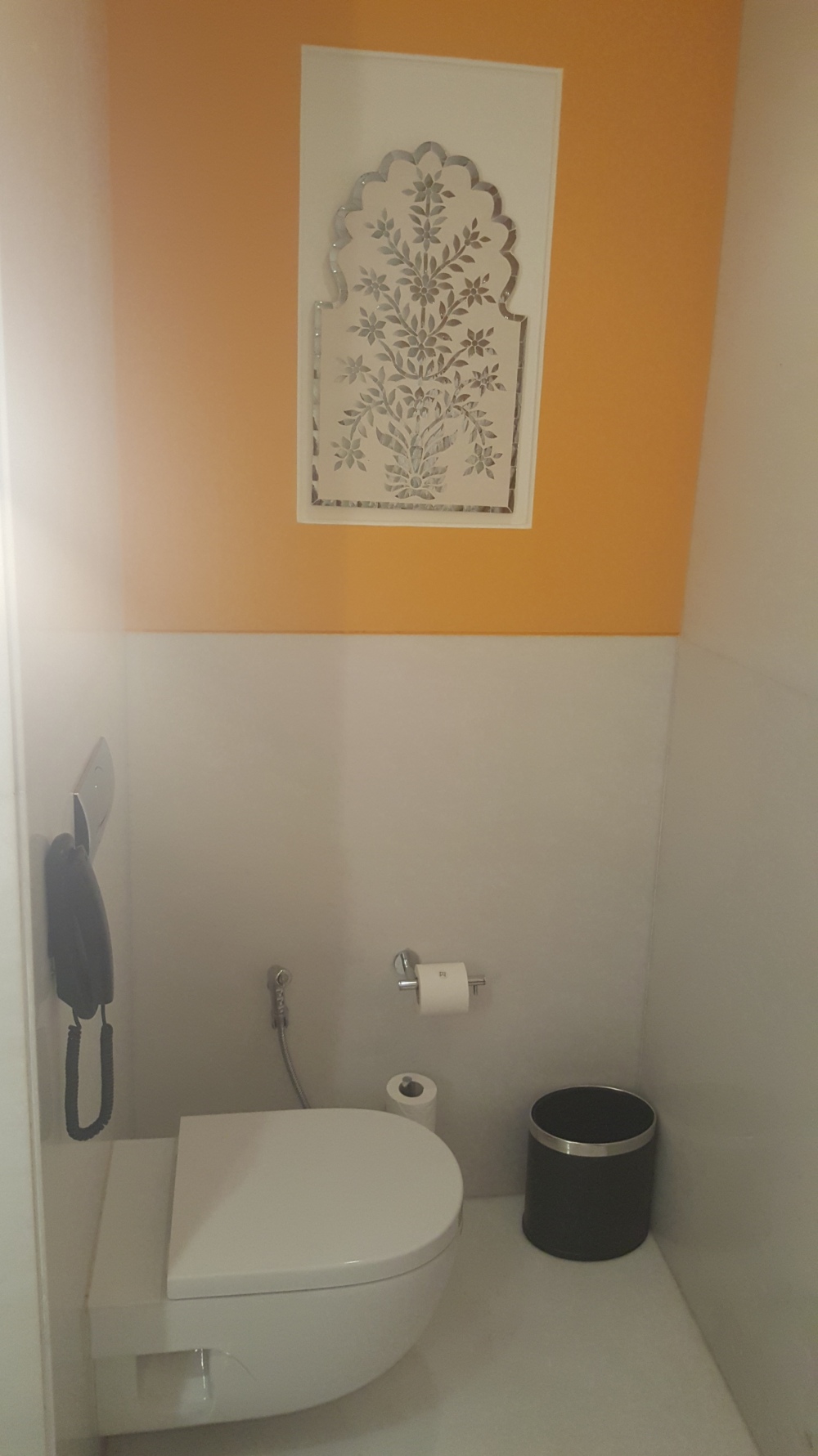















In conclusion, an amazing stay, even though we regret not having sufficient time to fully experience all that the resort had to offer. Then again, there’s always next time 🙂
DAY 4: JAIPUR via Ajmer
Next day, as dawn rose we hurtled along in our pleasingly regal convoy. En route we stopped to visit Umaid Bhawan Palace.
The Umaid Bhawan Palace is among the best kept palaces in India. Part of the palace is now run by the Taj Group of Hotels. It is said that as the region was going through drought and famine the then ruler commissioned this project to provide employment to people. The construction of this palace started in 1929 and completed in 1943. The red sandstone building is designed by the renowned architect Henry Lanchester. Henry Lanchester was at that time an understudy of Edwin Lutyens who designed New Delhi. An interesting feature is that the chiseled sandstone of the palace have been put together in a system of interlocking without using any mortar.


The palace renovation, which is an expensive preposition, is taken care of and also it ensures a steady income to the current Maharaja of Jodhpur. However, only a very small portion of this beautiful 347 room palace remains open for the tourist to look and admire.




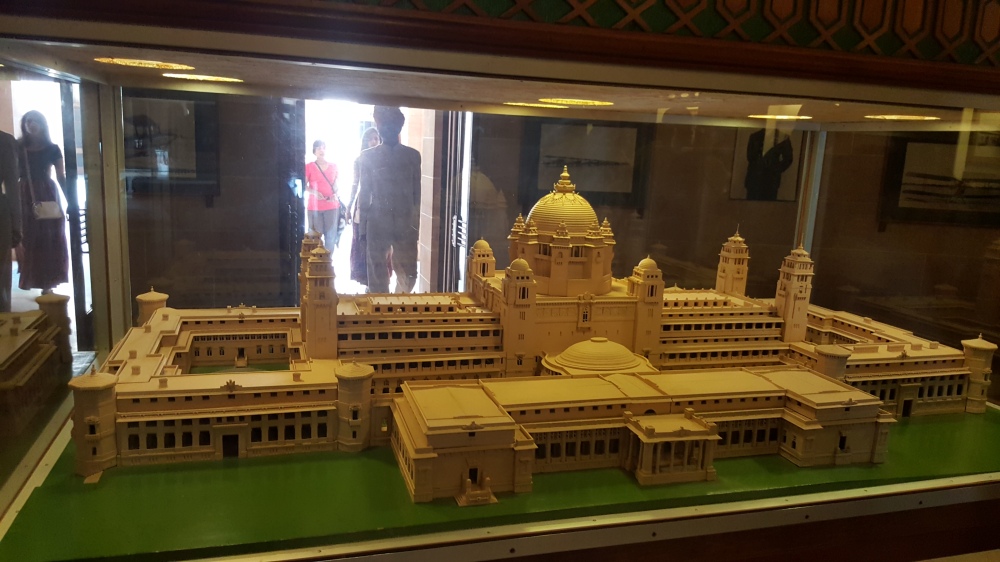
The main museum inside the main building houses antique weapons, clocks, watches and crockery etc.

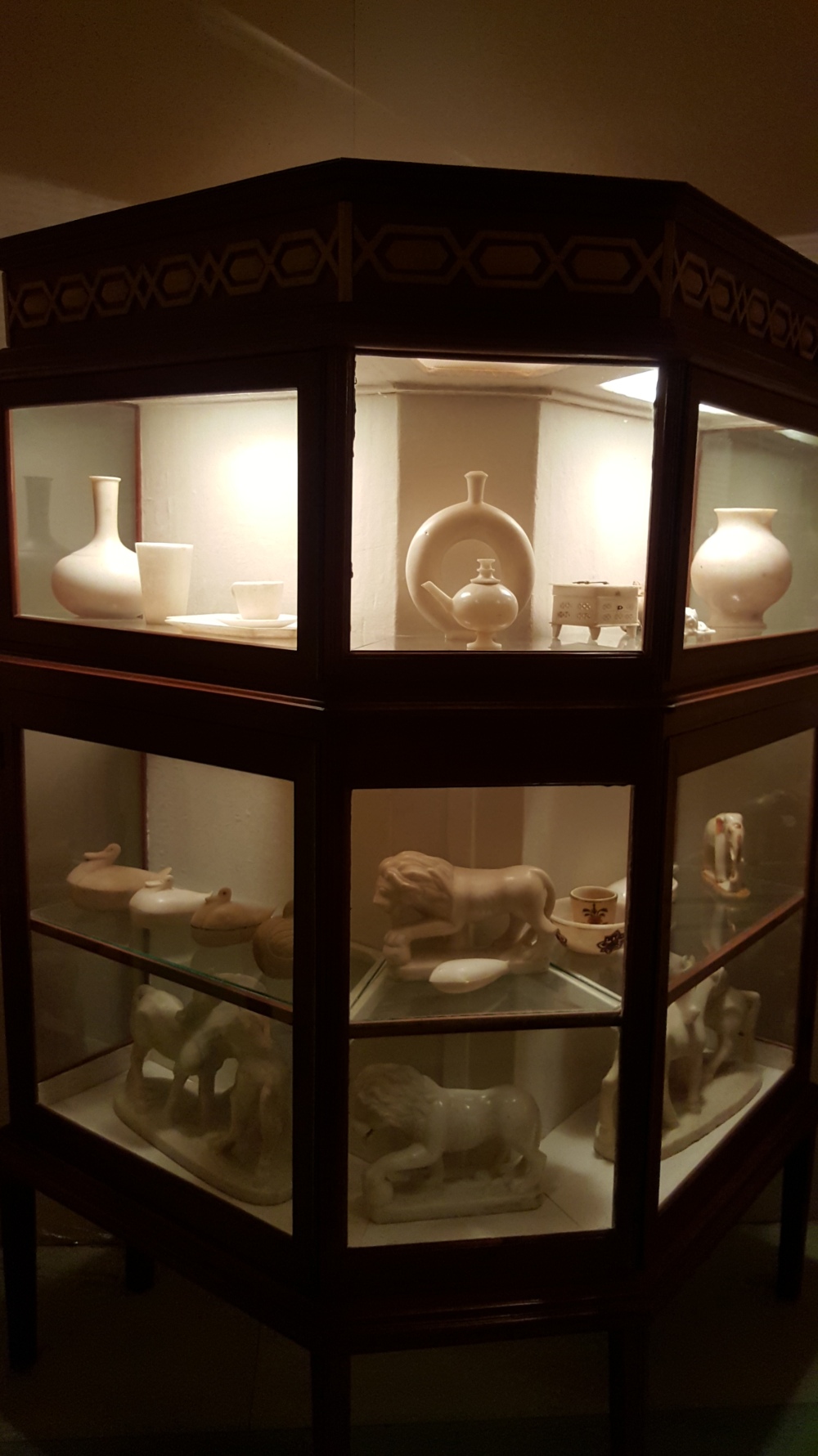







The palace is surrounded by well maintained lawns and gardens spread over 26 acres. On the premises is also a museum containing the vintage cars owned by the royal family. The vintage car area is in glass enclosures facing west.



We stopped for a quick lunch at Galaxy restaurant which is located on Ajmer by-pass road…



….spotted a few deers on the drive



…and reached the Fern Ecotel hotel at around 5 pm. The main purpose of booking this hotel away from the city centre was owing to it’s close proximity to the airport and a 20 min drive to Choki Dhani.




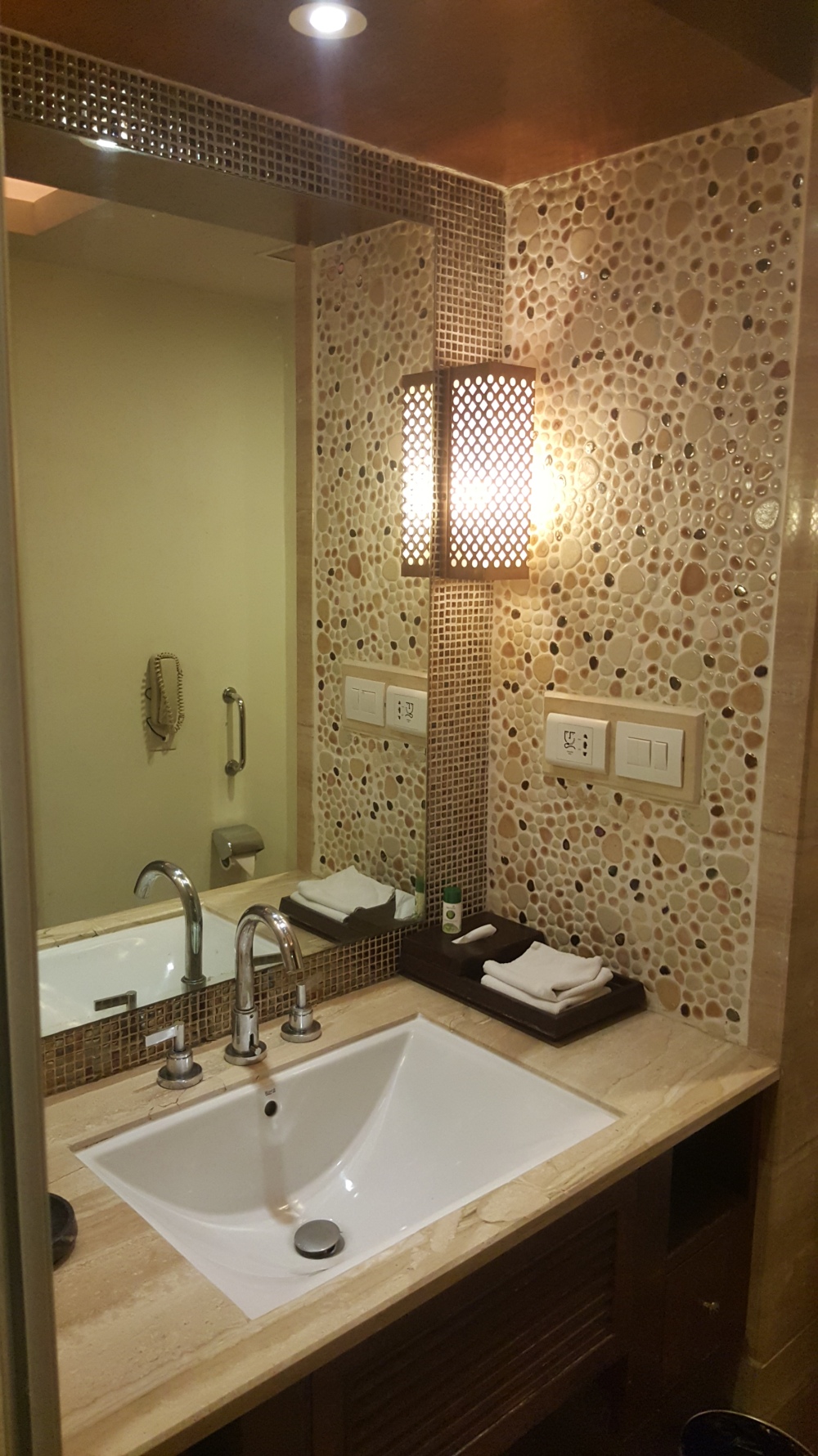

A quick shower and we were ready to leave for Choki Dhani. We booked a car through the hotel for Rs. 1000 for a round trip. Our driver insisted we visit Amber Vatika which has a similar concept to Choki Dhani. Both the venues are located opposite each other.
Amber Vatika is an entertainment spot where a person is familiarised with the basic culture and nature of Rajasthani people and where you get to taste almost all the authentic Rajasthani food under one roof.

The entry itself is grand with Dhol-Nagadas and dancers dancing around.

The entry fee includes welcome drinks, mehendi, bajre ki roti-makhan, hukka, four course meal, various games, music shows, dance shows,puppet shows, magic shows and some rides. Very few stalls, such as the clothes store and game zones are chargeable.

Rickshaws are available for rides for free and if you want to pedal it yourself the workers will be more than happy to shoot funny videos on your phone or recorders.


 Huts are made in conventional manner, providing the place an amazingly veritable look. People working there are dressed traditionally as well.
Huts are made in conventional manner, providing the place an amazingly veritable look. People working there are dressed traditionally as well.



Female folk dancers perform on folk songs to offer the tourists the impeccable taste of their art forms.



Inside the immense compound camel rides are also available with very reasonable charges (Rs. 20 per person).

Small flea markets are installed at few points in the vatika, if you forgot to buy a memoir for someone back home you can do it then and there.

The main dining hut where the four course meal is provided. Their hospitality and humility is amazing. The serving staff consider you as their own guests and continuously serve you with mouth watering Rajasthani delicacies till you put your foot down and say “Please, no more” 🙂
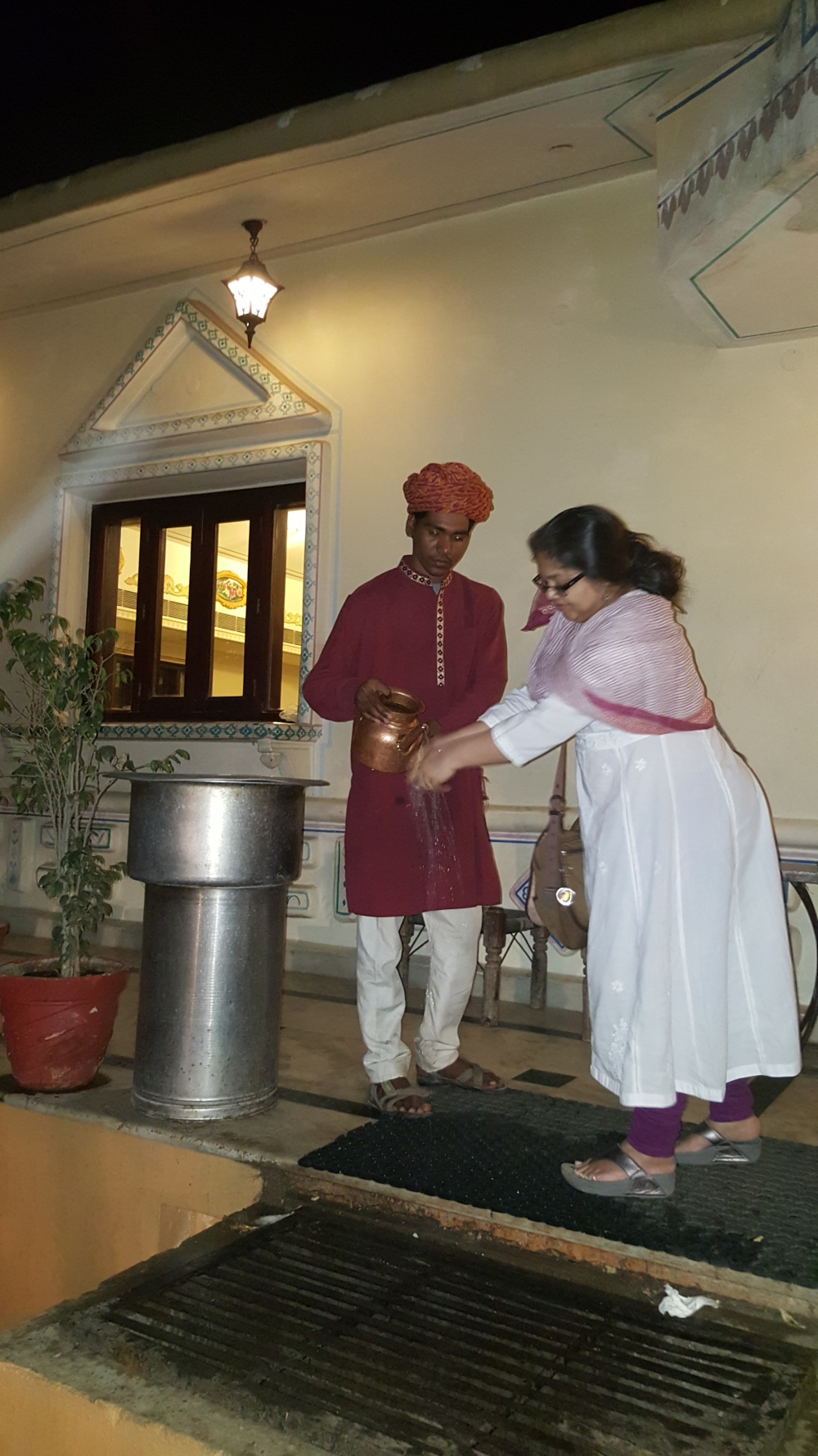
Serving the conventional thali consisting of excellent daal baati choorma, bajre ki khichdi, gatte ki sabzi, mouth watering malpuas and countless other lip smacking dishes; everything with generous amounts of ghee (butter). They push the whole concept of culture in its true form, a little over the edge!


We spent an hour at Amber Vatika and somehow felt our Jaipur visit was incomplete so asked the driver to take us to Choki Dhani. We were extremely glad we did.
Choki Dhani: a mock Rajasthani village that takes you on a journey through Rajasthani culture. Chokhi Dhani, literally means a “fine hamlet”, implying a archetypal village setting that provides you with an ultimate and supreme rural and rustic familiarity. The splendor and the concept make sure that it falls in line with a real village setup. Countryside games, traditional folk songs, magic shows as well as puppet shows await the presence of your esteemed self to cast a spell that will surely take you on a hayride into the cultural world.
















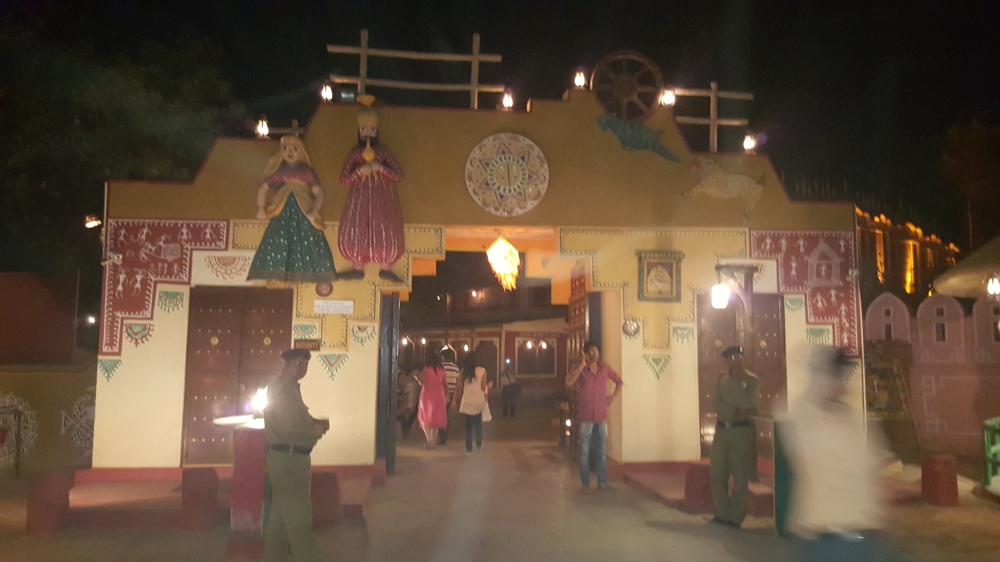
Traveling into Rajasthan is a thrilling experience but more abiding impression is of the people of Rajasthan. They are simple and happy people in spite of all the difficult conditions they are put to face. The dryness and insipidity of their surroundings has taught them the value of colors which they reflect in their costumes, in their paintings, in their handicrafts and even in their thoughts. Men wear on their heads turbans of dazzling bright colors and women have a special love for richly wrought ornaments and embroidered dresses.


I realized Rajasthan’s hospitality is its iconic trademark, but even its friendliness is so off-the-cuff. Although Rajasthan is a highly conservative state, the locals respect a visitor’s individuality. People are friendly and they give you space to do your own thing. The inherent warmth, amiable gestures and support melts your hesitation to travel solo. The locals in general know that they have to receive each guest with reverence.
Some of my most memorable moments were dining at Baradari restaurant , catching a panoramic view of Udaipur and Jodhpur, watching the sunset at Maharana Pratap Memorial in Udaipur, seeing the grandeur of the forts and palaces and the serene boat ride on Lake Pichola.

